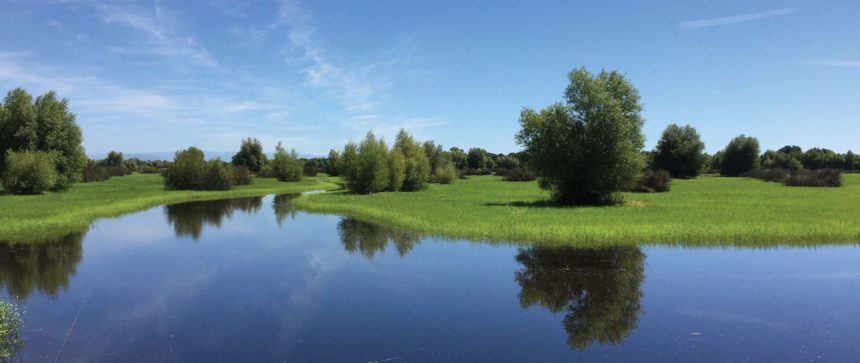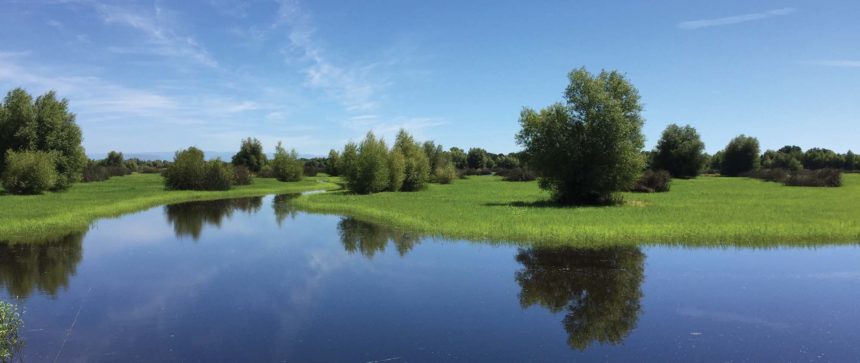
Sep 1, 2021
State expected to stop treating Central Valley wetlands as polluters
- California began treating wetlands as polluters in 2003, lumping them into a monitoring program with agricultural operations that discharge pollutants into the state water supply.
- This treatment has added costs for state wildlife areas, national wildlife refuges and duck clubs.
- CWA has been working since 2014 to remove wetlands from the monitoring program.
- A regulatory agency appears to be on board, and a final decision is expected in October.

By Jeffrey A. Volberg
Originally published in the Fall 2021 issue of California Waterfowl)
A draft resolution, if adopted, will no longer require wildlife refuges and duck clubs to participate in the Irrigated Lands Regulatory Program and pay the required fees.
The Central Valley Regional Water Quality Control Board is moving to remove managed wetlands from the Irrigated Lands Regulatory Program – the culmination of a process that started in 2014.
A workgroup including wetlands managers and Regional Water Quality Control Board staff has explored how to ensure that managed wetlands meet water quality requirements without having to report on pollutant discharges and pay fees, when managed wetlands typically do not discharge pollutants into the state’s water supply.
HOW THIS SYSTEM EVOLVED
Nine regional water quality control boards in California were created to regulate discharges of pollutants into the waters of the state under the federal Clean Water Act and the state Porter-Cologne Act. The Central Valley regional board regulates much of the agricultural discharges in the state.
Agriculture in California mostly relies on irrigation. Farmers apply water to their fields, which grow crops. Not all the water is taken up by the crops, however, and some water is drained off the fields and “discharged” into lakes, streams or groundwater. The drained water may contain fertilizer, salts, herbicides, pesticides, pathogens and sediment.
For several years, the regional boards issued “conditional waivers” for agricultural producers that allowed them to discharge agricultural wastewater into rivers, streams and groundwater, as long as they used certain “best management practices” to reduce pollution. Environmentalists felt that this allowed excessive amounts of pollutants to be discharged into water bodies, so the regional boards created the Irrigated Lands Regulatory Program (ILRP) in 2003.
Under the ILRP, farmers gather into coalitions to monitor water quality. The farmers pay fees for the coalition to conduct a monitoring program. The results of the monitoring are sent to the Regional Board each year, and any pollution that exceeds water quality standards is addressed. In the Sacramento Valley, for instance, the coalition’s monitoring program is conducted by the Northern California Water Association.
The monitoring reports include specific reports on nitrates and sediment, along with more general water quality results. While the fees charged to agricultural producers under the ILRP are expensive, they are a cost of doing business that is covered by the sale of crops. For the most part, monitoring results do not exceed water quality standards, because farmers are careful to use practices that minimize the amount of pollutants discharged.
WETLANDS INCLUDED
In the process of creating the ILRP, managed wetlands were included as if they were irrigated agricultural lands. Managed wetlands are wetlands that are actively managed to optimize the habitat value for waterfowl and other waterbirds. Habitat optimization is necessary because 95% of the historical wetlands in California have been reclaimed or drained and put to other uses. To provide habitat for the millions of birds that migrate each year along the Pacific Flyway, wetlands are artificially irrigated during the summer to grow food plants and flooded in the fall and spring for the migrations.
California Waterfowl is actively involved in restoring, maintaining and managing wetlands on federal wildlife refuges, state wildlife areas and private duck clubs, including CWA-owned properties. The money used to carry out these projects is acquired through state and federal grants, as well as private donations. The money is limited, and regulatory costs divert much of the money that could be used to provide better habitat for birds.
Participation in the ILRP costs money in fees, as well as requires administrative efforts to monitor water quality and report to the Regional Board each year. However, wetlands managers do not use many of the chemicals that farmers do, such as nitrates, and their irrigation practices usually do not produce much sediment.
SOLVING THE PROBLEM
To their credit, Regional Board staff convened a working group in 2014 to discuss how to properly regulate water quality on managed wetlands. The working group included managers from the San Luis National Wildlife Refuge, Gray Lodge Wildlife Area and Kern National Wildlife Refuge. Jonathan Pickett, a former California Waterfowl biologist, represented wetlands managers in the Tulare Basin.
The wetlands managers made three main points:
- Managed wetlands do not discharge significant amounts of nitrates and sediments because their practices are not the same as agricultural irrigation practices.
- Paying regulatory fees and complying with regulatory reporting requirements divert money and other resources that could be put to more constructive use in protecting the environment.
- Managed wetlands generally do not produce a revenue stream like commercial agriculture that can be used to pay regulatory fees.
In addition, the Tulare Basin wetlands managers argued that they pumped groundwater onto their properties to flood them up and then allowed the water to percolate back into the soil without being discharged into another water body.
After several months of discussion, Regional Board staff proposed to the board itself that managed wetlands no longer be required to produce reports on nitrate and sediment discharges, and that the Tulare Basin managed wetlands be exempted from the ILRP. Regional Board staff invited California Waterfowl to participate in their presentation to the Regional Board. The Regional Board accepted staff’s recommendation through a resolution.
SOLUTION AT HAND
This spring, the Regional Board circulated a draft resolution for comment. If adopted, the resolution will remove managed wetlands entirely from the ILRP. Any water quality problems that do arise on managed wetlands will be addressed on a case-by-case basis through other regulatory methods. California Waterfowl submitted comments that applauded the Regional Board’s resolution and its staff’s efforts and recommended that the Regional Board adopt the resolution as written.
The resolution is scheduled to be heard by the Regional Board this October. If it is adopted, wildlife refuges and duck clubs will no longer have to participate in the ILRP and pay the required fees.
The Central Valley Regional Board and its staff have shown great common sense. Their efforts and their willingness to engage with wetlands managers and to understand their concerns are greatly appreciated.
If you would like more information about the ILRP, or if you have information to share, please contact Mark Hennelly at mhennelly@calwaterfowl.org or 916-648-1406, ext. 105.


